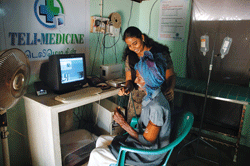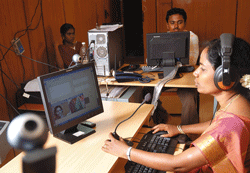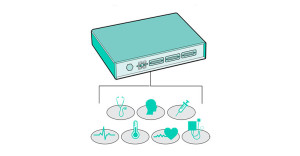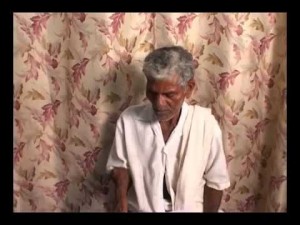Neurosynaptic Communications’ affordable tele-medicine solutions help rural folk access quality medical care.
 REMOTE SENSING: Agents at rural IT kiosks run diagnostic units, data from which can be viewed by doctors elsewhere.
REMOTE SENSING: Agents at rural IT kiosks run diagnostic units, data from which can be viewed by doctors elsewhere.
Like most doctors, Radha Srinivasan’s day starts early, which is hardly surprising, given the steady stream of patients waiting to meet her. Unlike other doctors though, Radha begins her workday by logging on to Yahoo Messenger. No, she isn’t a chat addict; it’s just part of her job, which also involves treating patients who live in remote locations. By logging on to the messenger service, Radha is merely indicating to the person manning the rural information technology kiosk miles away that she is ready to diagnose her first patient.
On the day we met her, it was 41-year-old Vijaya C, who had logged on from Iraniyur, some 15 km from Tirupattur (near Madurai). Because Vijaya’s medical parameters are already fed into the system, it takes only a few minutes for the doctor to pronounce her diagnosis—viral infection. Quickly, Radha moves on to her next patient, while we are left wondering about the technology that helps her in this endeavour. It is tele-medicine alright, but with a difference. It’s affordable and has an in-built diagnostic solution. And, the company that has pioneered this innovation is a little-known boutique firm based out of Bangalore, Neurosynaptic Communications.
Neurosynaptic’s journey began in 2002 when founders Sameer Sawarkar (currently its CEO) and Rajeev Kumar (Director) quit their salaried jobs, and decided to turn entrepreneurs. Sawarkar and Kumar were communication and signal processing engineers with a passion—to explore opportunities involving the central nervous system (brain waves, in particular) and combine that with electronics.
“We knew that next-generation solutions would be inter-disciplinary in nature—the era of one domain or one technology is passe,” Sawarkar says. “The future is all about different domains and the technologies available in those domains coming together to create new solutions. We wanted to be a part of this movement.” Soon, the duo got in touch with Professor Vijay Raghavan of the National Centre for Biological Sciences. He, in turn, referred them to Ashok Jhunjhunwala and his TeNet Group at IIT Madras, which was working towards transforming rural areas through the use of technology.
It was during their numerous visits to the TeNet centres that the duo decided to shift track and focus on the huge untapped opportunity in rural healthcare delivery.
They wondered if tele-medicine could bridge the gap between what was needed and what was available. Was it possible to bring patients and doctors together on a single platform even if they were physically apart? Some work was going on in this field in a few rural IT kiosks—like basic video-conferencing and remote imaging for cataract patients—but it was inadequate in terms of helping a doctor get relevant information to make a proper diagnosis.
For instance, the doctor had no way of checking a patient’s blood pressure, pulse rate or temperature—such things could not be done remotely. That was what prompted Sawarkar and Kumar to develop the idea of building a diagnostic capability. They also realised that there was a need to build a full-fledged solution that would allow connectivity with a doctor if required.
After speaking to a cross-section of doctors, they identified a basic set of parameters that could be built into an easy-to-use diagnostic unit. These included body temperature, blood pressure, heart sound, height and weight measurement, electro cardiogram and some basic imaging. The idea was to capture this data, both for current use as well as for subsequent visits to the doctor. Agents at rural IT kiosks would be trained to operate the unit and store the data, which could then be viewed by the doctor remotely.
Building the ecosystem
The first challenge they faced was connectivity. “There was work going on in the field of tele-medicine by Apollo Hospitals, but it involved expensive satellite connectivity. Besides Apollo’s rural tele-medicine is a not-for-profit initiative,” says Sawarkar. “Some hospitals also operated specialty mobile vans for dispensing primary and secondary healthcare, but as a business proposition, it wasn’t viable because the costs incurred were very high. We knew that unless our solution was affordable, it could not be sustained or scaled up.”
The Neurosynaptic tele-medicine solution, which comprises a hardware device that measures a person's key medical parameters, works on Internet speeds of as low as 32 kbpsMonths of intensive research later, the duo developed a solution that worked on a low-speed Internet connection (as low as 32 kbps). It comprised a hardware device that measured key medical parameters. This was connected to a computer loaded with software that filed the data, just like a hospital’s medical record.
The record could then be transmitted via the Internet to a doctor, miles away. The doctor and patients communicated with each other through video-conferencing that was configured for the Internet. The patient only had to walk to the nearest rural IT kiosk, get the diagnostic parameters taken and then consult the doctor—just for Rs 25.
But developing the solution was only one part of the work. “You need to build a whole ecosystem on top of this technology—you need to work along with a back-end of doctors for consultation, rural pharmacies as well as the connectivity providers to ensure our solution delivers what we promised,” Kumar says. “That’s where we are looking to build partnerships.”
Revenue model
After testing the solution extensively through 2006 and early-2007, Neurosynaptic deployed its rural healthcare solution starting with Tamil Nadu (there are currently 10 relay centres there). The initial response was good.
Thirty-eight-year-old Muthu Chinnakalai of Iraniyur village, who uses Neurosynaptic’s solution to monitor his blood sugar levels, says it is a godsend for rural folk like him who have no access to medical facilities. P Kalaiselvi, who visited the Iraniyur centre complaining of persistent fever, was shocked to see patients being treated without the physical presence of a doctor. “Now we are used to it—all my family members come here regularly for check-ups,” she says.
With proof-of-concept established, Neurosynaptic is now looking to scale up and foray into other states. It has tied up with a local hospital in Maharashtra, and in
Uttar Pradesh, it is working with an NGO. “We have received a lot of enquires from other states—from both government and private players—and are in the process of finalising a few projects,” says Kumar.
Neurosynaptic is also looking at a third round of funding (the two earlier rounds were funded by Ventureast TeNet and APIDC. “It will be a reasonably large amount,” Sawarkar says, without going into details.
As of now, Neurosynaptic’s revenue model varies from project to project. In UP, for example, it earns an upfront licence fee in addition to implementation and annual maintenance fees.
But in Tamil Nadu and Maharashtra, where the solution is deployed on third-party infrastructure, it is a revenue-sharing model. Sawarkar and Kumar are both tight-lipped about revenue and profit figures, but insist their model is financially viable. They cite Neurosynaptic’s inclusion in the World Economic Forum’s list of 39 global technology pioneers as validation of their model. “We are the only Indian company to be featured in this elite list,” says Sawarkar.
Source:
![]()
http://www.outlookbusiness.com/article_v3.aspx?artid=101559



